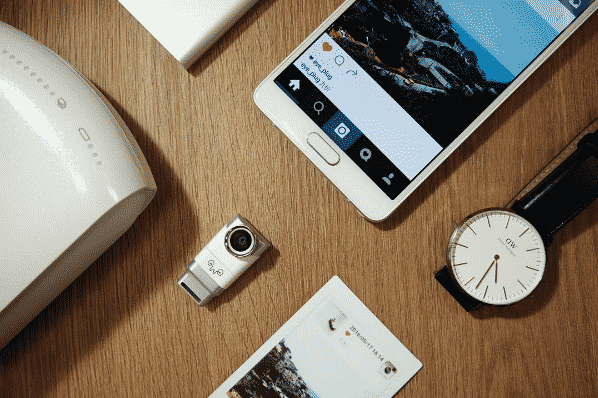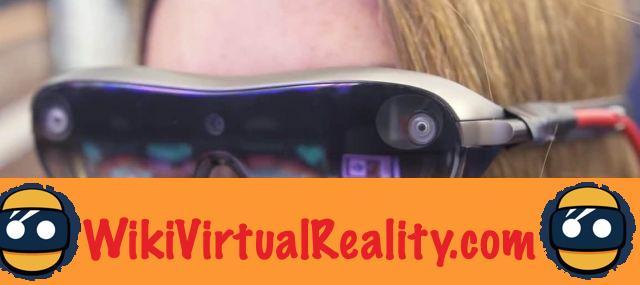![[Test] VR Orbit Theater: a good standalone Android headset… but no VR on the horizon!](/images/posts/9fd602a44aa93bfb3da44f2f06d60246-0.jpg)
Summary
- Buy the VR Orbit Theater
- Unboxing of the VR Orbit Theater: a quality packaging
- VR Orbit Theater design: a superhero look
- Features of the VR Orbit Theater: a mid-range Android setup
- Getting started and using the VR Orbit Theater
- Conclusion: the VR Orbit Theater, which audience? What uses?
- Buy the VR Orbit Theater
Le mobile VR market is currently trusted by two big giants: on the one hand Samsung, and his VR Gear designed in partnership with the mastodon Oculus and the other Google, with his Cardboard. Initially presented in 2014, during the annual mass of the Mountain View firm, the Cardboard is a cardboard VR mask system, today distributed in more than 10 million copies. With open-source plans allowing anyone to create their own Cardboard, Google has had a keen nose and offered a Entrance door to the extremely accessible RV.
Inspired by this system using the user's smartphone, many “Cardboard type” helmets have emerged. Improved lenses, addition of buttons, plastic manufacturing… Today there are many helmets on the market, of varying quality, allowing people to experience VR via their smartphone. It is also the bet, successful, of Samsung, which, by joining forces with Oculus, conquered more than 5 million users around the world. Just recently, HTC, renowned for the quality of its Vive headset, announced its intention to launch into mobile VR with the HTC Link, a device that works with the HTC U11, the latest flagship of the Taiwanese brand.
![[Test] VR Orbit Theater: a good standalone Android headset… but no VR on the horizon!](/images/posts/9fd602a44aa93bfb3da44f2f06d60246-1.jpg)
With its VR Orbit Theater French brand VR Orbit has decided to go beyond the smartphone to offer a completely autonomous mobile VR headset. Faced with the giants Samsung, Google and other Homido who occupy the niche market for mobile VR, what place does this French initiative deserve? Packaging, design, ergonomics, comfort… Let's review the VR Orbit Theater.
Buy the VR Orbit Theater
Brand: VR Orbit
Model: theater
Compatibility: screen feedback possible on PC via micro-USB / USB
Login: Bluetooth 4.1 et Wi-Fi
Price: 349 euros
Availability: already available
Unboxing of the VR Orbit Theater: a quality packaging
![[Test] VR Orbit Theater: a good standalone Android headset… but no VR on the horizon!](/images/posts/9fd602a44aa93bfb3da44f2f06d60246-2.jpg)
![[Test] VR Orbit Theater: a good standalone Android headset… but no VR on the horizon!](/images/posts/9fd602a44aa93bfb3da44f2f06d60246-3.jpg)
![[Test] VR Orbit Theater: a good standalone Android headset… but no VR on the horizon!](/images/posts/9fd602a44aa93bfb3da44f2f06d60246-4.jpg)
Headphone packaging VR Orbit Theater is rather classic: black plastic on which the helmet, in front of a green light, is represented. On the front face, under the logo, a list indicates the elements present in the pack: the Orbit Theater VR headset, a mouse and its adapter, a cleaning cloth, a pair of in-ear headphones and two sets of eartips as well as a carrying case. To discover all this, you have to slide the cardboard packaging and reveal a black hard cardboard box. It contains all of the elements mentioned above. No micro-USB card is provided.
VR Orbit Theater design: a superhero look
![[Test] VR Orbit Theater: a good standalone Android headset… but no VR on the horizon!](/images/posts/9fd602a44aa93bfb3da44f2f06d60246-5.jpg)
Very often, commercial photos succeed in embellishing the visual appearance of certain products. Surprisingly, in the case of the VR Orbit Theater, the reverse process applied. If it appears to sport a classic design, the VR Orbit Theater is, once in hand, a nice aesthetic surprise.
Once in hand, the first striking thing is the lightness of the helmet. With only 300 grams displayed on the scale, the VR Orbit Theater offers a optimal comfort. The whole helmet is covered with black rubber (quite similar to that of Google's Nexus 5, moreover presented the same day as the Google Cardboard), pleasant to the touch but very sensitive to fingerprints. A protective foam surrounds the back of the helmet. This one however seems fragile. In fact, on our model, it tended to come off; however, nothing disturbing when using the VR Orbit Theater. The helmet is held on the user's head thanks to fabric straps, adjustable via velcro straps.
![[Test] VR Orbit Theater: a good standalone Android headset… but no VR on the horizon!](/images/posts/9fd602a44aa93bfb3da44f2f06d60246-6.jpg)
On top of the VR Orbit Theater, we find two sliding knobs that allow you to adjust the lens spacing. Between the two, the VR Orbit logo appears. It can also be seen on the left edge, just above the port jack 3.5mm. On the opposite side is located a USB port, where you can connect the adapter supplied with the bluetooth mouse, as well as a micro-SD card slot. Face, the geometry and curves of the VR Orbit Theater give it an air of futuristic glasses, finally quite close to that worn by Cyclops in X-Men. An LED is present on the top, to indicate the operating and charging status of the device.
![[Test] VR Orbit Theater: a good standalone Android headset… but no VR on the horizon!](/images/posts/9fd602a44aa93bfb3da44f2f06d60246-7.jpg)
It's certain the lower edge of the Orbit Theater VR headset that hide the controls allowing you to interact with the software of the stand-alone headset: on the left, a power / standby button and a back button. On the other side, VR Orbit has integrated a multi-directional cross with a validation button at its center. A last button, to the left of the keypad, allows you toactivate and deactivate the 3D function. We will come back to that.
We're pretty convinced by the look of the VR Orbit Theater. Except for one member, the entire editorial staff was unanimous on the helmet design, deemed successful. We still regret the feeling of fragility inspired by the protective foam.
![[Test] VR Orbit Theater: a good standalone Android headset… but no VR on the horizon!](/images/posts/9fd602a44aa93bfb3da44f2f06d60246-8.jpg)
When worn, the Orbit Theater VR headset is quite comfortable. integrated controls, after a few minutes of adaptation, quickly become easy to access and use. If the effort of raising the arm to reach the underside of the helmet becomes disturbing, interface can be controlled with mouse. To do this, you must plug the USB adapter into the side of the VR Orbit Theater. Very discreet, it will not interfere with the use of the mobile device. Mouse navigation in the Android interface, relatively close to the stock versions that Google puts forward on its Nexus and Pixels, is however quite difficult to understand. VR Orbit does not offer no overlay strictly speaking, just a personalized launcher. We are faced with a very classic Android Lollipop 5.1 interface, optimized for touch and much less for the pointer of a mouse.
Features of the VR Orbit Theater: a mid-range Android setup
![[Test] VR Orbit Theater: a good standalone Android headset… but no VR on the horizon!](/images/posts/9fd602a44aa93bfb3da44f2f06d60246-9.jpg)
The Theater is an autonomous headset but integrates the same components as most Android smartphones. The French brand is fairly secret about the components of its product. Note all the same the presence of two 2K LCD screens, An 6-axis gyroscope and accelerometer, An 3 200 mAh batteries (offering a maximum autonomy announced of 3 hours), WiFi, bluetooth 4.0 and 16 GB of internal storage, expandable up to 128 GB, by micro-SD. No mention of the graphics chip or processor and its speed - we just know that this is a Rockchip SoC. Everything is powered by a very little modified version of Android 5.1. At a time when Android O is pointing the tip of its nose, we are surprised to see a new and recent device delivered under Lollipop.
Getting started and using the VR Orbit Theater
![[Test] VR Orbit Theater: a good standalone Android headset… but no VR on the horizon!](/images/posts/9fd602a44aa93bfb3da44f2f06d60246-10.jpg)
Again, what is striking when getting started with the VR Orbit Theater is its featherweight. On the head, it is easily forgotten as long as we manage to adjust the straps correctly. To start the device, press the power button. During the boot sequence, no mention of Google or even Android. Past the VR Orbit logo, we access a home launcher. 5 applications are available.
Applications pre-installed on the VR Orbit Theater
![[Test] VR Orbit Theater: a good standalone Android headset… but no VR on the horizon!](/images/posts/9fd602a44aa93bfb3da44f2f06d60246-11.jpg)
"Library" regroup the multimedia content (photos, videos and 360 °) present on the device and, if applicable, on the micro-SD card. A proprietary application brings together 360 content in the form of a hub, in a virtual Zen atmosphere: a sofa and cushions as well as a large window. Like Oculus Home, it will be on the eye-tracking that it will be necessary to count within this app.
The VR Orbit Theater also offers nnavigate on the internet, via the Google browser, Chrome. We then find an “Apps” folder which will act like the applications drawer very popular on Android. Note that it is in this folder that the Google Play Store which will allow'' add VR applications to the headset. Some applications are delivered installed on the headset. During the first use, we can therefore launch YouTube, WearVR, Google Play Services (renamed Services for the occasion), Tube Mate and Google Play Newsstand.
Also present, a fairly complete file manager. Finally, the latest application on the VR Orbit Theater desktop is a shortcut to the settings menu. This is where we will have to go to configure a WiFi connection, required for downloading applications; the VR Orbit Theater does not have a 3G or LTE connection. Entering text, with the mouse, on a touchscreen keyboard, in a VR headset, is not very intuitive. Exercise is not an ordeal; but the whole clearly lacks fluidity and speed, suggesting that situations involving entering text will be avoided as much as possible. Too bad not to have integrated voice input!
Navigating the VR Orbit Theater interface
![[Test] VR Orbit Theater: a good standalone Android headset… but no VR on the horizon!](/images/posts/9fd602a44aa93bfb3da44f2f06d60246-12.jpg)
Regarding navigation, two choices are available to the user : we can use the buttons on the headset itself or prefer the mouse. If it is, at first glance, surprising to use a mouse in a classic Android mobile interface, we quickly take a hand. The use of buttons is good but ultimately, the mouse quickly takes over, relieving the arm and avoiding pressing errors. The left click will act as a validation button, the right click acts as a back button and the scroll wheel is used to navigate.
No notification bar is present. Only the WiFi and battery icons are present, along with the percentage and the time. Some notifications will still appear at the top of the screen. It seems impossible to interact with them without the bluetooth mouse.
Using the headset in VR mode
![[Test] VR Orbit Theater: a good standalone Android headset… but no VR on the horizon!](/images/posts/9fd602a44aa93bfb3da44f2f06d60246-13.jpg)
When we think of a VR headset, all the more mobile, we easily associate it with VR games and 360 content. For this last activity, the VR Orbit Theater is doing very well. Despite a little aging LED technology, the 2K screen offers picture quality pleasing to the eye. Gyroscopes and other accelerometers ensure a good experience to enjoy 360 photos and 360 videos, whether stored locally or online. The 3D button allows you to enjoy 360 3D content creating a feeling of depth. Except for compatible videos, this feature will have little interest in the rest of the interface. With a headset connected, you can imagine wearing the VR Orbit Theater for a movie without inconvenience. So, the VR Orbit Theater, more of a multimedia projection headset than a real VR headset? The very name of the product gives us a clue ...
VR is indeed not the best ground to demonstrate the capabilities of the VR Orbit Theater. No VR app is pre-installed on the device. It will be up to the user to make his market… and this is where the shoe pinches. The Orbit Theater VR headset is not not listed among the known cardboards by Google within its application. Most cardboard applications, if usable, are not optimized and you end up in a VR experience, as if you were looking at a movie screen. When it comes to videos, it can be nice. On the other hand, when playing games, the VR experience immediately becomes disappointing and less immersive than what headsets like the Samsung Gear VR or the Google Daydream offer. Worse: very often, the image is oddly divided, not even making it possible to distinguish the entire virtual world.
Conclusion: the VR Orbit Theater, which audience? What uses?
![[Test] VR Orbit Theater: a good standalone Android headset… but no VR on the horizon!](/images/posts/9fd602a44aa93bfb3da44f2f06d60246-14.jpg)
Autonomous headset under Android Lollipop. The Lille brand's bet is daring. The VR Orbit Theater has a fairly hybrid positioning between mobile VR headset and multimedia headset. The idea of offering a free smartphone headset is quite honorable. However, the software part is lagging behind. We would have appreciated a completely VR optimized Android version, or at least the official support of Google's Cardboard app.. As it stands, the VR Orbit Theater is aimed more at lovers of multimedia content, especially 360, but not only. We can easily imagine this type of headset replacing the portable DVD player that children take on vacation or even the tablet on which we take care of during a train trip. On the other hand, it is difficult to recommend the VR Orbit Theater to people looking for a headset to enjoy virtual reality.
Good pointsComfortable and light
Good picture quality
No overheating and / or noise
Negative points
A software part struggling
Limited interest in VR
Buy the VR Orbit Theater
7.3
Unboxing : The packaging of the VR Orbit Theater gives a premium appearance to the product. Items provided such as the carrying case are appreciated.
Design: From materials to lightness through aesthetics, the VR Orbit Theater is a success.
Features: Judging by how little information is available, the specifications seem a bit behind for such a recent product.
Getting started and using: : The navigation with the buttons is quite easy. With the mouse, it will take a little time to adapt. The headset offers good image quality for viewing content but is clearly not VR oriented.
( votes)

![[Test] VR Orbit Theater: a good standalone Android headset… but no VR on the horizon!](/images/logo.png)



![[GOOD TIP] The DJI Mavic Air drone at only 970 euros 🔥](/images/posts/508c7088bbc439b2faabf0ee3721dc83-0.jpg)
![[WWDC 2017] Mac VR: Apple computers running macOS High Sierra compatible with HTC Vive](/images/posts/1efe8a66c6dc80ec888133efad603474-0.jpg)
![[Review] Augmented Empire - A fascinating cyberpunk tactical RPG on Samsung Gear VR](/images/posts/e59f79c2980c7163a7cfe93c1a40e553-0.jpg)


















